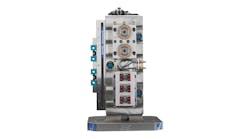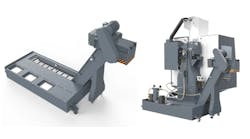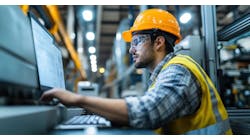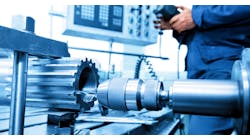Safety remains a top priority for manufacturers striving to reduce workplace hazards and improve overall efficiency. Technological advancements have been crucial for minimizing risks, ensuring compliance with safety standards, and protecting workers from potential dangers. Innovations such as AI-driven predictive maintenance, wearable safety devices, and virtual reality training are transforming how safety is managed in industrial environments.
By integrating these cutting-edge solutions, manufacturers can create a safer and more productive workplace. This is particularly important given that, in 2020, the private manufacturing industry reported 373,300 nonfatal injuries and illnesses, according to the US Bureau of Labor Statistics (BLS). Embracing advanced technologies can significantly reduce these incidents, fostering a safer environment for all employees.
AI-driven predictive maintenance
Artificial intelligence (AI) and machine learning are revolutionizing predictive maintenance, allowing manufacturers to foresee and prevent equipment failures before they lead to hazardous situations. Conventional maintenance strategies often involve scheduled inspections or reactive repairs, both of which can be inefficient and risky. AI-driven predictive maintenance uses real-time data to analyze equipment performance and detect potential issues before they escalate.
Sensors and Industrial Internet of Things (IIoT) devices continuously monitor parameters like temperature, vibration, and pressure. When an anomaly is detected, the AI system triggers an alert, allowing maintenance teams to address the issue before it causes unexpected downtime or a safety incident.
For example, ultrasonic flow meters are used to monitor fluid flow in pipelines and detect leaks that could lead to hazardous spills or equipment malfunctions. By identifying potential failures in advance, AI-driven predictive maintenance enhances safety, reduces operational costs, and improves overall efficiency.
Wearable safety devices
Wearable technology is becoming integral to workplace safety by providing real-time monitoring of workers’ health and environmental conditions. These smart devices are designed to prevent injuries, track workers' locations, and detect hazardous conditions in real time.
- Smart helmets: Equipped with augmented reality (AR) displays, sensors, and communication features, smart helmets provide real-time data about environmental hazards, machinery status, and emergency alerts. Workers can receive hands-free instructions while staying aware of potential risks.
- Exoskeletons: Designed to reduce strain on workers' muscles and joints, exoskeletons provide mechanical assistance, allowing employees to lift heavy objects with less effort. This technology significantly reduces the risk of musculoskeletal injuries.
- Biometric wearables: These devices monitor workers’ vital signs, such as heart rate, body temperature, and fatigue levels. If a worker shows signs of exhaustion or exposure to hazardous conditions, supervisors can intervene before an accident occurs.
VR training for hazard prevention
Training workers in a safe and controlled environment is critical for preventing accidents, and virtual reality (VR) is proving to be a game-changer in this area. Conventional training methods often involve on-the-job experience, which can be risky for new employees. VR technology allows workers to experience realistic simulations of hazardous scenarios without being exposed to actual dangers.
- Hazard identification training: Employees can navigate virtual manufacturing environments to learn how to recognize and mitigate potential hazards.
- Emergency response drills: VR enables workers to practice emergency procedures, such as fire evacuation and chemical spill response, ensuring they are prepared for real-life incidents.
- Equipment handling training: Workers can operate complex machinery in a virtual setting, gaining hands-on experience before using actual equipment.
By incorporating VR training into their safety programs, manufacturers can enhance employee preparedness and reduce workplace accidents.
Automation for risk reduction
Robotics and automation have significantly improved workplace safety by taking over dangerous and repetitive tasks, reducing the risk of human error and injury. Robots are now used to perform high-risk operations, including material handling, welding, and hazardous substance handling.
Collaborative robots (cobots) work alongside human employees, assisting them in tasks that require precision and strength. These cobots are equipped with sensors that prevent collisions, ensuring a safe working environment. Automated guided vehicles (AGVs) are also being used in manufacturing facilities to transport heavy loads, reducing the need for manual lifting and decreasing the likelihood of musculoskeletal injuries.
By integrating robotics and automation, manufacturers can enhance both productivity and worker safety, minimizing exposure to dangerous conditions.
AGVs for workplace safety
Automated guided vehicles (AGVs) are transforming safety in manufacturing by reducing the risk of accidents related to material handling. These self-navigating vehicles transport raw materials, components, and finished goods throughout a facility without requiring human operation, minimizing the chances of forklift collisions, dropped loads, or worker injuries.
AGVs use sensors, cameras, and LiDAR technology to detect obstacles and adjust their routes in real-time, ensuring safe and efficient movement. According to BLS, in 2023 forklift-related incidents resulted in 67 fatalities. Implementing AGVs can significantly lower these risks by minimizing human error and ensuring safer material transportation.
Digital safety compliance and reporting
Digital safety compliance platforms streamline the process of monitoring and reporting workplace incidents. These systems allow companies to maintain compliance with regulatory standards while ensuring that safety protocols are effectively enforced.
- Mobile reporting apps: Workers can report hazards, near-misses, and incidents in real time using mobile applications, ensuring prompt action is taken.
- Automated safety audits: AI-powered software can conduct routine safety audits, identifying compliance gaps and recommending corrective measures.
- Data analytics for safety improvement: By analyzing incident reports and safety data, manufacturers can identify patterns and implement proactive measures to prevent future accidents.
The future of safety
Technology plays a vital role in improving safety in manufacturing. AI-driven predictive maintenance, wearable safety devices, VR training, robotics, AGVs, and advanced monitoring systems are transforming how companies protect their workforce. Innovations like ultrasonic flow meters help detect potential failures before they become hazardous, while digital safety compliance tools ensure regulatory adherence.
By embracing these technologies, manufacturing professionals can significantly reduce workplace accidents, enhance efficiency, and create a safer, more sustainable working environment. As these advancements continue to evolve, manufacturers must remain proactive in integrating the latest safety innovations to protect their workers and maintain operational excellence.






